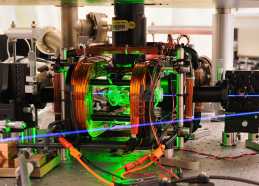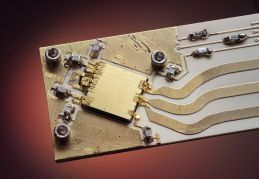Physicists entangle 2 atoms using microwaves for the first time
August 11, 2011

A pair of ions are trapped by electric fields and manipulated with microwaves inside a glass chamber at the center of the apparatus. An ultraviolet laser beam, used to cool the ions and detect their quantum state, is colorized blue for visibility (credit: Y. Colombe/NIST)
Physicists at the National Institute of Standards and Technology (NIST) have entangled two separated ions (electrically charged atoms) by manipulating them with microwaves instead of the usual laser beams.
The research suggests it may be possible to replace an exotic room-sized quantum computing “laser park” with miniaturized, commercial microwave technology similar to that used in smart phones.
The team is the first to position microwave sources just 30 micrometers away from the ions to create the conditions enabling entanglement, the quantum phenomenon expected to be crucial for transporting information and correcting errors in quantum computers. Ions are a leading candidate for use as quantum bits (qubits) to hold information in a quantum computer, the scientists said.
In the experiments, two ions were held by electromagnetic fields, hovering above an ion trap chip consisting of gold electrodes electroplated onto an aluminum nitride backing. Some of the electrodes were activated to create pulses of oscillating microwave radiation around the ions. Radiation frequencies are in the 1 to 2 gigahertz range. The microwaves produce magnetic fields used to rotate the ions’ spins, which can be thought of as tiny bar magnets pointing in different directions. The orientation of these tiny bar magnets is one of the quantum properties used to represent information.

Gold ion trap on aluminum nitride backing. In NIST microwave quantum computing experiments, two ions hover above the middle of the square gold trap, which measures 7.4 millimeters on a side. Scientists manipulate and entangle the ions using microwaves fed into wires on the trap from the three thick electrodes at the lower right (credit: Y. Colombe/NIST)
The scientists entangled the ions by adapting a technique they first developed with lasers. If the microwaves’ magnetic fields gradually increase across the ions in just the right way, the ions’ motion can be excited depending on the spin orientations, and the spins can become entangled in the process.
The scientists had to find the right combination of settings for the three electrodes that provided the optimal change in the oscillating magnetic fields across the extent of the ions’ motion while minimizing unwanted effects.
The properties of the entangled ions are linked, so a measurement of one ion would reveal the state of the other.
The scientists achieved entanglement 76 percent of the time, well above the minimum threshold of 50 percent defining the onset of quantum properties, but not yet competitive with the best laser-controlled operations at 99.3 percent.
Compared to complex, expensive laser sources, microwave components could be expanded and upgraded more easily to build practical systems of thousands of ions for quantum computing and simulations, the scientists said. The use of microwaves also reduces errors introduced by instabilities in laser beam pointing and power as well as laser-induced spontaneous emissions by the ions. However, microwave operations need to be improved to enable practical quantum computations or simulations.
Ref.: C. Ospelkaus, et al., Microwave quantum logic gates for trapped ions, Nature, 2011; [DOI:10.1038/nature10290]